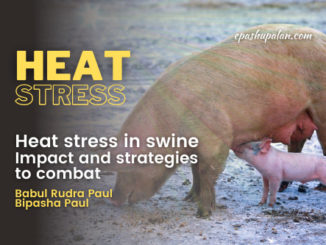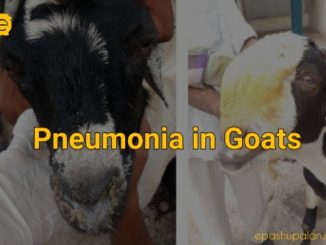African swine fever (ASF) is a highly contagious hemorrhagic viral disease of domestic and wild pigs. The causative agent of African Swine Fever is African swine fever virus (ASFV). African swine fever virus is a large, double-stranded DNA virus in the Asfarviridae family. The clinical sign and symptoms of the disease are similar to Classical swine fever (CSF), but Classical swine fever virus is not related to African swine fever virus. African swine fever (ASF) is the only virus with a double-stranded DNA genome known to be transmitted by arthropods.
Origin of the virus
The virus is thought to be derived from a virus of soft tick (genus Ornithodoros) that infects wild swine, including giant forest hogs (Hylochoerus meinertzhageni), warthogs (Phacochoerus africanus), and bushpigs (Potamochoerus porcus). In these wild hosts, infection is generally asymptomatic.

Transmission
Transmission of African swine fever virus is by direct contact with infected domestic or wild pig or contaminated material, through ingestion of contaminated feeding material, or through biological vectors. African swine fever virus infects ticks of the genus Ornithodoros, these ticks act as a vector and transmit the disease to domestic or wild pig.
Public health risk
African swine fever virus does not cause disease in humans, so it is not a risk to human health
Clinical Sign
African swine fever can present as a peracute, acute, subacute or chronic disease, and some animals may
seroconvert without becoming ill.
- Peracute Form: Sudden deaths with few lesions (peracute cases) may be the first sign of an infection in some herds.
- Acute Form: Acute cases are characterized by a high fever, anorexia, lethargy, weakness, recumbency and Hemorrhages in the skin (redness of skin on ears, abdomen and legs). Respiratory signs (including dyspnea), nasal and conjunctival discharges, and neurological signs have been reported. Pigs may also experience diarrhea or vomiting, Pregnant animals frequently abort, Death often occurs within 7-10 days. Mortality rates may be as high as 100%.
- Subacute Form: Subacute African swine fever is similar to acute form, but with less severe clinical signs. Abortions are sometimes the first sign of an outbreak in this form. Affected pigs usually die or recover within 3 to 4 weeks.
- Chronic Form: Pigs with the chronic form have nonspecific signs such as an intermittent low fever, appetite loss and depression. but some pigs develop respiratory problems and swollen joints. Coughing is common, and diarrhea and occasional vomiting have been reported. some pigs develop respiratory problems and swollen joints and arthritis.
Post Mortem Lesions
Post Mortem lesion differ in African swine fever depending on the strain and the species of pig infected. bluish discoloration of skin with hemorrhage, bloody froth from nose and mouth, discharge of pus from the eyes, sighn of bloddy faeces.
- Acute Form: The lesion observed in acute form of African Swine fever are fluids in the chest and abdominal cavities, which may be blood-stained, extensive haemorrhages in mandibular, renal and gastrohepatic lymph nodes, spleen and kidney and occasionally in the heart, congestive splenomegaly, Petechiae in the the mucous membrane of the urinary bladder, larynx and pleura
- Subacute form: The lesions observed in the sub-acute form of African Swine fever are mild versions of those described for the acute form, congested and oedematous lung and in some cases an interstitial pneumonia.
- Chronic: TThe lesions observed in the sub-acute form of African Swine fever are characterised by enlarged lymph nodes and spleen, pleuritis and fibrous pericarditis. focal caseous necrosis and mineralisation of the lungs may exist.
Diagnosis
The clinical symptoms of African swine fever virus infection are very similar to Classical swine fever, and the two diseases normally have to be distinguished by laboratory diagnosis.
Prevention and Control
Presently there is no approved vaccine for African swine fever virus commercially available. Post recovery immunity appears to be largely strain specific. During disease outbreaks, early detection and human killing of all pigs and the proper disposal of carcases and all waste material is critical. Other important aspects to consider are the cleaning and disinfecting of affected farms, designation of the infected area and restriction on animal movements. Serological surveys should be undertaken in the surrounding area. The involvement of the soft tick vector should also be considered in the control programme
Reference:
- Mazur-Panasiuk, Natalia; Woźniakowski, Grzegorz; Niemczuk, Krzysztof (14 March 2019). Scientific Reports. 9 (1): 4556.
- Sanchez Botija C, 1982. African swine fever. New developments Rev. Sci. Techol. Off. Int. Epizoot., 1:1065-1094.
- Gomez-Villamandos J, Bautista M, Hervas J, Carrasco J, Cahcon F, Perez J, Sierra M, 1996. Subcellular changes in platelets in acute and subacute African swine fever. J. Comp. Pathol., 59:146-151.
- Mebus CA, McVicar JW, Dardiri AH, 1983. Comparison of the pathology of high and low virulence African swine fever virus infections. African swine fever., 183-194; [Report EUR 8466 EN]; 14 ref.
- Spickler A.R. & Roth J.A. Iowa State University, College of Veterinary Medicine
- Michaud, V; Randriamparany, T; Albina, E (2013). PLOS One. 8 (7): e69662.
| The content of the articles are accurate and true to the best of the author’s knowledge. It is not meant to substitute for diagnosis, prognosis, treatment, prescription, or formal and individualized advice from a veterinary medical professional. Animals exhibiting signs and symptoms of distress should be seen by a veterinarian immediately. |






Nice informative article on ASF in present context. The disease is 1st time appeared in the Assam and Arunachal Pradesh of India. Tissue Samples are confirmed for ASF virus by real time PCR and sequencing. As no vaccine and treatment are available for ASF, strict biosafety measures should be implemented.